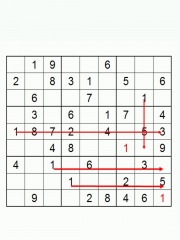How to solve Sudoku
I have posted some neat and simple techniques for solving Sudoku puzzles. These are some simple tips.
Every trick under the sun to solve harder and expert sudoku puzzles would take another 10 or more articles. As such, I've kept it sweet and simple.
Easy Puzzles
1. Use the counting principles to solve the puzzles. Since you already know that you can't have the same number in any row, column, or nine-square block, you can use that to help you get a number. The difficulty depends on the placement of the numbers given to you.
2. Seek "definites". When solving an easy Sudoku, the first thing you should do is look for definites. Definites are numbers that are definitely going to be there. Starting at 1, draw imaginary lines through boxes in that 1's row and/or column. When there is only one box left in the 3x3 box, you know that is a definite.
3. Work your way through the numbers until 9. Since you have filled in some numbers, this should help get other numbers that had more than one possibility before. (See images three and four. Notice how the 3s could not have been solved before, but are solved in the final).
4. Look again when stuck. If you get stuck, go back and make sure to look at everything. It is almost guaranteed you missed something. That one number is usually all you need to get going again. If you still cannot find any solutions, start labeling every block with every number that could possibly go in that box. For example, in image one, all the empty boxes have numbers that could possibly go there. Fill these in. If there is a 1 in the row or column of that box, you know that 1 is not a possibility.
5. Start by doing Sudoku in the newspaper or online. The newspaper Sudokus are usually easier on Monday and Tuesday. The difficulty increases as the week passes.


This particular Sudoku (images one and two) could be solved with only definites, but what do you do if it can't?
Hard Puzzles
Start at number 1. Use the same logic from an easy puzzle to fill in every empty box with all of the possible numbers for that box. If possible, put in definites. For example, picture three shows that you can't solve for 3. In a hard Sudoku, you won't be able to solve from the start, so just fill in what you know it could be.) This will help later when you have two or three options per box and you can't remember what they are.
Note that if two boxes in a block, column or row must be one of two numbers, you can use those to eliminate other possibilities. For example, in a block, there are four open boxes. From your analysis, you have determined that:
- box A can be 1, 2, 3, or 4;
- box B can be 1, 2, 3, or 4;
- box C can be 3 or 4; and
- box D can be 3 or 4.
- From this we know that box A and B cannot be 3 or 4, because they have to be either 1 or 2. Box C and D have to be either 3 or 4. This information might be useful in solving other boxes.
Recognize that hard Sudokus can take time - a lot of time. A hard Sudoku can actually take days to complete, but they are still fun. The harder they are, the more fun it is when you finish. A hard Sudoku can be solved the same as an easy one, it just gives you less to start with. The logic of a hard puzzle is that if you know everything that can go in every box, it is very simple. For example, if you have two possible 2s for a particular nine-square box, and they are in a row or column and you know that 2s cannot go anywhere else in the nine-square box, then you know that the row or column those 2s are in cannot have 2s in it except in this nine-square box. This sounds confusing, but when applied, it is actually very easy and it helps a lot.
Consider this alternative, sure fire way to always solve a puzzle accurately and quickly. In this method, fill in each block with all the possible numbers that could go there. Write all the numbers small at the top of the block. You can recreate the puzzle on bigger paper to help with this. Write all the numbers that don't appear in that row, column or square. Once you have done this for a whole column or row, start filling in the obvious answers. You will have solved the puzzle by the time you do this for every row.
